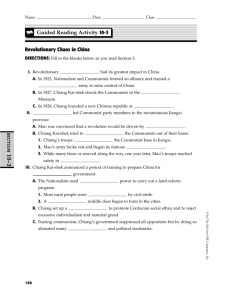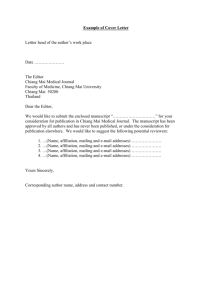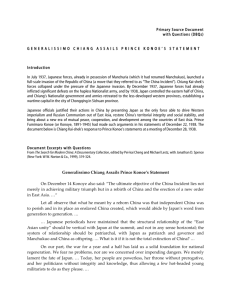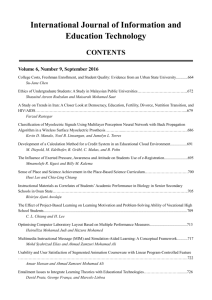EC2040-Mathematics and Statistics Methods
advertisement
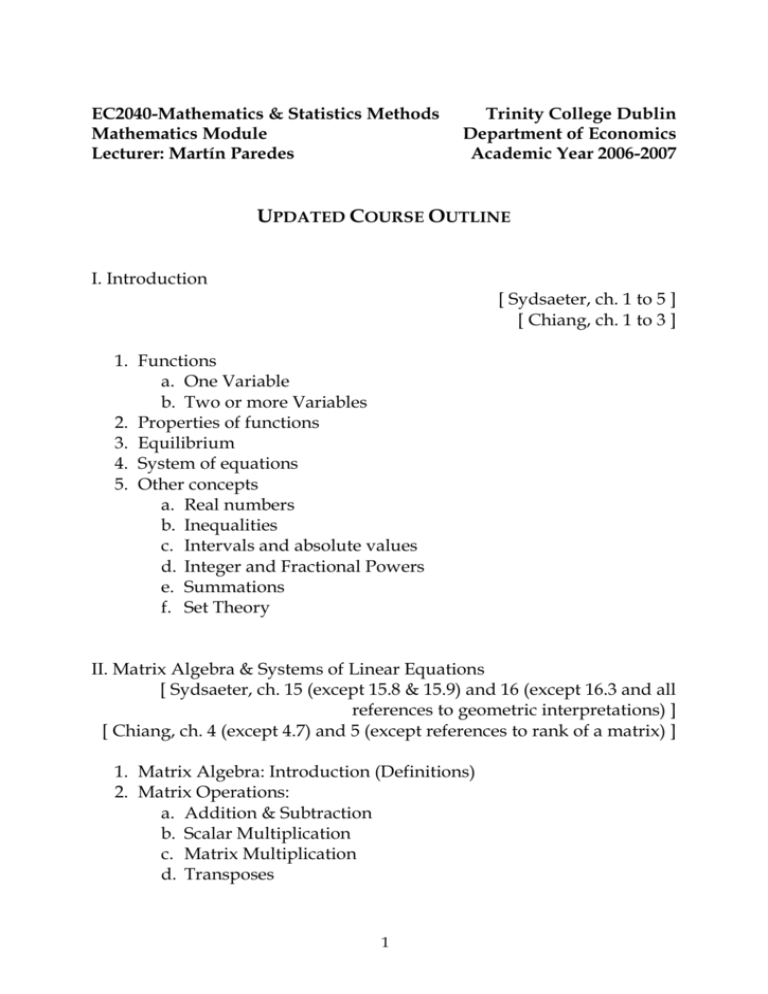
EC2040-Mathematics & Statistics Methods Mathematics Module Lecturer: Martín Paredes Trinity College Dublin Department of Economics Academic Year 2006-2007 UPDATED COURSE OUTLINE I. Introduction [ Sydsaeter, ch. 1 to 5 ] [ Chiang, ch. 1 to 3 ] 1. Functions a. One Variable b. Two or more Variables 2. Properties of functions 3. Equilibrium 4. System of equations 5. Other concepts a. Real numbers b. Inequalities c. Intervals and absolute values d. Integer and Fractional Powers e. Summations f. Set Theory II. Matrix Algebra & Systems of Linear Equations [ Sydsaeter, ch. 15 (except 15.8 & 15.9) and 16 (except 16.3 and all references to geometric interpretations) ] [ Chiang, ch. 4 (except 4.7) and 5 (except references to rank of a matrix) ] 1. Matrix Algebra: Introduction (Definitions) 2. Matrix Operations: a. Addition & Subtraction b. Scalar Multiplication c. Matrix Multiplication d. Transposes 1 e. Determinants i. Use of Laplace Expansion to find determinants ii. Sarrus’ rule for 3x3 ONLY f. Inverse of a Matrix i. Gaussian Elimination Method (Use of Elementary Row Operations) ii. Find the adjoint and the determinant of the matrix. 3. Solution of Systems of Linear Equations a. Gaussian Elimination Method (Use of Elementary Row Operations) b. Find the Inverse c. Cramer’s rule 4. Application: Input-Output Analysis III. Derivatives of Functions of One Variable [ Sydsaeter, ch. 6 & 7 (up to 7.9) ] [ Chiang, ch. 6, 7.1 to 7.3, 8.1, 8.5 (up to p. 199), 9.3 & 9.5 ] 1. Definition and interpretation a. Difference quotient b. Derivative c. Increasing and decreasing functions d. Limits e. Continuity vs differentiability 2. Rules of Differentiation a. Constant function b. Power function c. Sum of two functions d. Product of two functions e. Quotient of two functions f. Chain rule g. Inverse function h. Exponential and logarithmic functions 3. Higher-order derivatives a. Concave and convex functions b. Linear and polynomial approximations 4. Differential of a function 2 IV. Derivatives of Functions of Two or More Variables [ Sydsaeter, ch. 11 (except 11.3 &11.4) 12.1, 12.2, 12.6 (except pp. 435-436) & 12.9 ] [ Chiang, ch. 7.4 to 7.6, 8.2 and 8.3 ] 1. 2. 3. 4. 5. Definitions Rules Applications Differentials Matrices of Derivatives: a. Jacobian matrix b. Hessian matrix 6. Chain rules for many variables 7. Derivatives of implicit functions 8. Other concepts a. Partial Elasticities b. Homogenous Functions V. Optimization of Functions of One Variable (no constraints) [ Sydsaeter, ch. 8 (except 8.4) ] [ Chiang, ch. 9 (except 9.3 & 9.5) ] 1. 2. 3. 4. 5. 6. Maximum and minimum points First-Derivative test for Extreme points Second- Derivative test Nth Derivative Test Other critical values Economic Examples: VI. Multivariate Optimization (no constraints) [ Sydsaeter, ch. 13 (except 13.5 &13.6) ] [ Chiang, ch. 11.1, 11.2, 11.4 & 11.6 ] 1. First-Order condition 2. Second-Order condition 3. Economic Examples. 3 VII. Optimization with Equality Constraints [ Sydsaeter, ch. 14 (except 14.3, 14.5, 14.7 & 14.8) ] [ Chiang, ch. 12.1 to 12.3 (up to p. 361), and 12.5 to 12.7 ] 1. 2. 3. 4. 5. 6. Use the Lagrange multiplier method First-Order condition Second-Order condition Interpretation of the Lagrangian multiplier Envelope Theorem Economic Examples 4
